Text, Texting and Web Text: The Most Basic Digital CommunicationA Digital Literacy ChapterThe idea of text, of writing, has been around for some 5,000 years. It's role in transforming human culture is incalcuable, but text is still a work in progress. The transformation in how text is used in the last 50 have been dramatic, an exponential whiplash of change. Two forces appear to be leading the evolution of text communication in particular and all communication in general, text messaging and Web pages. Seemingly opposed to these forces are educational systems that ban phones and/or texting during the school day while providing limited personal access to computing devices in general. Finding effective ways to integrate these new media within educational systems begins with understanding them and using them. It poses an important question to all educators. What innovation is necessary to integrate these new forces on the digital stage? The Internet with its email and World Wide Web of browsers has played a critical role in transforming what it means to compose and understand text in the 21st century, a change process still evolving. Though seemingly becoming superceded by decades of television, text has had the last laugh, becoming the glue by which all media can be merged in a single page or set of pages. This occurs both as an invisible command language and as a means of connecting content which integrates the conceptual ideas of different media. Text has become the integrating force between mobile phones and the Internet through the use of text messaging, which can be sent directly to phones or to Twitter (microblogging) sites which than can be transmitted back to millions who "follow" Twitter feeds on their phones in addition to other mobile digital devices. Text is also the easiest and cheapest way to take feedback or comments within an existing page of composition, transforming readers into co-authors. These uses of text are quite overt, but text also plays a covert role in the hidden HTML (HyperText Markup Language) that undergirds every Web browser page, every insertion of media, and plays a deeper role in the hidden nature of the software or computer programming that makes every action on a digital device possible. Text MessagingIt used to be that a phone was just a phone, just a device for voice communication. Then mobile phone companies discovered the value of text messaging as a new income stream. Nokia offered the first mobile phone capable of text messaging in 1993. After 2000, mobile phones were becoming smart phones, mobile pocket-sized computers with their own operating systems. In 2006 a product and company called Twitter became the dominant force in integrating the short text messages of mobile phones and the Web through the simple device of requiring Web page postings to fit in the space of a phone text message (140 keyboard characters) and enabling subscriptions services that send those postings (tweets) to and from any number of mobile phone or computer subscribers. By 2011, some 5 years later, over 1 billion tweets are sent weekly and 8 trillion text messages a year were being sent globally. The very act of fitting an idea within the space of a Tweet invokes editorial planning and more concise thinking and expression. Email is still an important element of professional and business communication, but its use among teenagers is undergoing a significant decline (Evans, 2011), with only those older than 55 showing an increase in the use of email. At the same time, social networking services such as Google+ and Facebook are providing new systems for organizing Web pages, providing a much more devoted "readership" and space for active personal compositions than the more traditional types of Web sites. It is becoming a contest between email and Web pages and Twitter and Facebook. For educators with needs for parent communication and student digital awareness, far more families have mobile phones than have computers with Internet access. These mobile devices have become the leading edge in promoting, even inadvertently, awareness of the digital age and its capacity. The use of tweets as a teaching format, or as review and reminders ("Flu", 2012), tied to a system for queuing and timing followup messages could provide one more way to use new text in novel and effective educational ways. Web Page CompositionWhere text messaging is short form, Web pages are long form, as long as any author wants to make them, with as many media as the composer knows how to integrate. This has had numerous implications. Web use begins with finding, reading and using online information. A 2003 report by Michigan State University (MSU) researchers discovered "that children who use the internet perform better on standardized tests and generally achieve higher grade-point averages than their less web-savvy peers" (Murray, 2003). How much more educationally valuable the web experience would be if learners were also creating the Web. In the words of the NCTE literacy compact, it is critical that administrators "give students and teachers access to the writing tools of the future: word processors, online networks, and computer software" (NCTE, 1996). To this writing composition process the web has added the concept of linking. This chapter focuses on linking text files. Later chapters examine the linking and integration of a wide range of multimedia. Web processing is the ability to build and grow your own little corner of the World Wide Web and to share it with others in every country of the world, such as the Thai students and teachers have done in their web links above. Web processing could be seen as an extension, a superset of writing and word processing. Composers are still concerned about the ideas and structures that build from words to sentences to paragraphs to documents, but on the web there is also an emphasis on the relationship between compositions, on large scale global editing. This is much more than standard word processing as the teachers in the image table above are learning. The concepts and procedures of linking distinguish web processing from word processing. This chapter addresses both the technical skills and the conceptual knowledge needed to begin. Since it is presumed that you already know the basics of word processing, the basics of linking web pages together will be introduced in this chapter and a more advanced exploration of word processing will follow in the next chapter. On the web, linking is the technical procedure for creating quick pathways between different sources of data, whether print, audio, video or other which are stored in public places on the Internet. Links in text are generally identified by their contrasting color and are often underlined as well. Other links can only be identified by the cursor changing from a pointing arrow to a hand shape. Sometimes these links are referred to as "hot buttons or image maps" which means that some area of an image or video serves as a clickable spot that jumps the user to a different source of information. Web design has to do with the arrangement of the interface or layout of the information and links to further information. Established effective web interfaces include the standard magazine model taught in this online text of these chapters, along with the more challenging spatial and interpersonal designs (Biocca, 2003). Though linking is a new technical procedure created for the Internet, the concept of linking has other meanings that are related to its Internet use in important ways. Conceptually, linking means making higher levels of meaning by the nature of the connection between sets of information. In this more general and broader meaning of linking, linking is a skill fundamental to both understanding what we are learning and passing on our knowledge to others (Ryder, 1999). Consequently, linking is one of the oldest and most important thinking skills of human culture. Culturally, the unique patterns of links between people, information, and their organizations and habits are what build communities and distinguish one set of human beings from another.
Work is even underway to link the
Researchers have been able to write computer algorithms that harness the neuronal responses of this bio-silicon technology to successfully control mechanical devices. In 2002 Steven Potter, a biomedical engineer at the University of Georgia, US, created the Hybrot - or “hybrid robot” - a cup-sized robot which used infrared sensors and "an array of rat neurons grafted to silicon electrodes" to control its movements. In 2004 Thomas DeMarse, a biomedical engineer at the University of Florida in Gainesville, US, created an array of 25,000 interconnected living neurons that used data from electronic sensors to control the flight of a jet plane in a virtual computer simulation (Biever, 2004). Compositionally, a composition is first and foremost a particular structure for a set of linked ideas. This organization of information comes in many forms. Collections of paragraphs become essays and collections of writing can become books. Collections of musical phrases become different forms of music. Collections of video clips become movies. Web page links represent one more new extension to the idea of composition. The link in the left margin to NCTE's "Call to Join the Literacy Compact" includes an emphasis on schools having and using current hardware and software and developing a realistic connection between real world problems, real world composition and classroom composition curriculum. Educationally, if you ever learned anything, you were linking. If you have taught or even thought about teaching, or if you have written, you have engaged in linking. Effective teaching, writing and linking requires a collection of information, a plan for linking this collection in some structure and a performance of a sequence of events or steps which may later be read, seen or heard. In general, educators do not compose the bulk of the articles, books,
music or movies that they use in their work, even though they are constantly
teaching these composition skills to their learners. Instead, educators
time is primarily spent in composing and working through sets of connections
to resources and ideas. These sets of connections are designed to move
the thinking of learners to new levels of understanding by adding onto
or transforming the learners' current set of mental links. Collections
of resources can be hooked into lessons. Collections of lessons can be
attached to what educators call unit plans, instructional units, plans
of action and individualized educational prescriptions (IEPs). In very
a similar way, web designers turn collections of links between electronic
files stored on the Internet into web sites.
Sometimes web based systems appear to create new problems. How do students complete assignments when they do not have access to the Internet at home or teachers use the web when Internet access does not come to their classroom? However, just as checking out a book and taking it home is a solution to a closed library, so is it possible to "check out" or download a web site to use when net connection is not possible. Because of the nature of link connections, an additional innovative feature is available to support the reading or viewing of web sites offline. The process of copying a large number of web pages at once on the web is sometimes called web whacking. A variety of different software tools can follow the links of a web site to allow entire web sites or different layers of a web site to copied to the hard drive of a personal computer. (This works as long as one has the hard drive space to hold the data.) Once this is done, the user can disconnect from the Internet and copy this information to a diskette or CD that can be read some where else, a place where there might not be Internet access or an Internet connection might be dysfunctionally slow. Reading or displaying web sites in this manner is also referred to as browsing offline. See the links in the left margin for web site capture software: Webstripper (free for personal use); Webwhacker or Web Miner. It turns out that educators were designers of learning webs centuries before the Internet and the World Wide Web was invented. To learn and teach is to link information together. Linking ideas and curriculum resources through the construction of web sites is a hand-in-glove fit with the professional practice of educators. Sometimes referred to as building curriculum webs (Cunningham & Billingsley, 2002) or making webquests, teacher organized web sites can provide important centers for learning for their classes. Teacher web sites also handle important administrative functions as well, for example, communicating assignments or reporting the password protected grades to parents and students. Though there are many similarities between web processing and word processing (which will be the focus on the next chapter), the differences are great enough that it can seem a bit of a shock to some. Linking and other web processing elements are transforming culture and education in a way that has not been seen or experienced for a very long time. In my judgment, web processing is the most important new idea to need placement in school curriculum since the invention of reading and writing. Actually, Imagine for a moment that you were a new teacher in a Greek school
around 700 B.C. and some
Now in the beginning of the twenty-first century, you are a part of
history repeating itself with an equally significant cultural transformation
based on web technology.
Like the excitement that writing must have generated, the enthusiasm for the Web comes from the differences that create new possibilities. Though paper technology remains valuable, linking (which requires computers, computer monitors and the Internet) provides many advantages. The electronic system of linking over a computer network (credits to Argonne Photo Gallery) provides much at a dramatically greater level, including greater: speed of delivery, convenience, global availability, instant edit ability, opportunity for media convergence, and high numbers of information resources that are immediately available in the classroom. Educators also find that creating and sharing weekly planners, lesson
plans, unit plans and relevant web sites and more through their online
The advantages of online web sites are balanced with several significant but relatively short term problems. These problems in order of significance include the lack of access to a computer for each student in the classroom throughout the school day, the comparative unreliability of computers and related technology requiring expensive technical support in a time of budget crisis, the digital divide problem of those students and families without digital skills or without the money to buy the needed technology at home, slow network connections at home and at school, the degree of education required to use the new tools, school district restrictions on professional use of the web, and the impermanence of resources stored on the Internet. There is also another somewhat hidden feature of this
learning. The skills in linking and related
If you feel that your students might also benefit from such income, be sure and pass along these skills, including business skills, to your students. Teenagers and younger students that have acquired this and other computer knowledge are becoming a force in the economic life of their communities in a way that has not been seen since the end of the agricultural age. In time, they might pay their way to college with this knowledge and educators might cover their expenses through graduate school. As the page linked in the left margin on "Why WNC Dies and Grows" reports, for some regions of the country, information age growth will be critical to the economic health and perhaps survival of many communities. Educators in turn might find that their school and classroom leadership in web processing can stimulate innovations in community leadership which will lead to other career developments and new businesses. As government employees, educators can partner with government small business and other government agencies to help students build organizations that use their skills with innovation and problem solving, whether for public service or profit. Growth in the use of the Internet is already significant, which increases
the expectation of employers and others that you use the Internet effectively.
Addressing the development of web pages is a major goal of this chapter, but with each chapter there is also meta-analysis activity that asks you to step back and think more deeply and interact with others more widely about both what you are learning and how you are learning. Keeping an eye on methodology as well as content is at the heart of the educational enterprise. The four topic structure with each chapter (LEAP: look, evoke, assess, publish) is one such course methodology. The Wonder Web activities and systems represent an additional way to integrate new tools and technologies with educational practice. Such work not only compliments existing practices but opens the door to the transformation of classroom and educational practice. How might Internet and web based educational designs transform classroom and other teaching practices? Online discussion opportunity. ============ Next: To complete this chapter, follow the "steps" down
the left column of this web page design. Sabrina's site is just one example
of how your web site might look at the end of the semester. The web site
model now being taught in these chapters will be similar in some ways to
Bibliography
Pub updated: 4.23.2012 |
||||||||
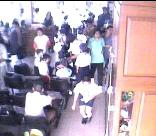
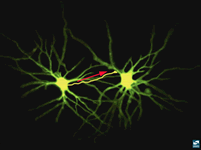 Biologically, linking is precisely what the brain does with
its neurons and dendrites as they form and reach out to connect with other
neurons and their dendrites. (See image on left; credit NIDA:
Biologically, linking is precisely what the brain does with
its neurons and dendrites as they form and reach out to connect with other
neurons and their dendrites. (See image on left; credit NIDA: 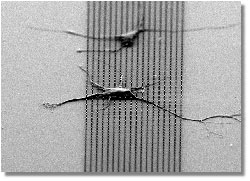
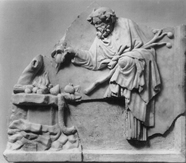 the shock of newness brought on by a new age of information
technology has been confronted at least four times in human culture. The
most recent occurred a couple of thousand years ago. Reading and writing
are very familiar concepts today, but just two to four millennia ago, people
did not know how to read and write. Education then was based on oral communication
and communication with stone images, drawing and painting skills. As this
stone tablet on the left illustrates (credit to
the shock of newness brought on by a new age of information
technology has been confronted at least four times in human culture. The
most recent occurred a couple of thousand years ago. Reading and writing
are very familiar concepts today, but just two to four millennia ago, people
did not know how to read and write. Education then was based on oral communication
and communication with stone images, drawing and painting skills. As this
stone tablet on the left illustrates (credit to  colleagues came in for dinner to talk about and
demonstrate these new concepts called writing and reading. You would have
been astounded by this new technology. You would have frustrated with its
unreliable input and storage systems, including slate, clay, cloth and
skins. Centuries would pass before paper would be invented and like the
ancient paper on the right (credit to LOC:
colleagues came in for dinner to talk about and
demonstrate these new concepts called writing and reading. You would have
been astounded by this new technology. You would have frustrated with its
unreliable input and storage systems, including slate, clay, cloth and
skins. Centuries would pass before paper would be invented and like the
ancient paper on the right (credit to LOC:  In
the last few years, web processing over the Internet has taken the concept of a
global electronic printing press and merged it with the idea of a global
telephone system, a global radio and TV station and more. However, as the page
linked in the left margin to "Copyright and Multimedia Policy" points out, this
will require attention to the legal issues involved. The mind spins again with
the possibilities for education. Based on the simple procedure of linking
data files over a computer network, computer workstations can feed distributing
web sites the results of their work on which others can build. This process has
become the basis for hurricanes of inventiveness which are underway around the
globe.
In
the last few years, web processing over the Internet has taken the concept of a
global electronic printing press and merged it with the idea of a global
telephone system, a global radio and TV station and more. However, as the page
linked in the left margin to "Copyright and Multimedia Policy" points out, this
will require attention to the legal issues involved. The mind spins again with
the possibilities for education. Based on the simple procedure of linking
data files over a computer network, computer workstations can feed distributing
web sites the results of their work on which others can build. This process has
become the basis for hurricanes of inventiveness which are underway around the
globe.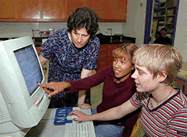 web sites documents and organizes their curriculum materials and goals
in a way that is not only professionally useful to themselves, but also
to their community of students and parents (credits to SNL:
web sites documents and organizes their curriculum materials and goals
in a way that is not only professionally useful to themselves, but also
to their community of students and parents (credits to SNL: 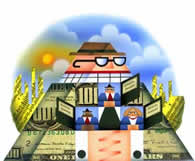 technologies
combined with knowledge about teaching and learning have great commercial value
in the business community and the global economy. (See picture/links on right;
credits to
technologies
combined with knowledge about teaching and learning have great commercial value
in the business community and the global economy. (See picture/links on right;
credits to